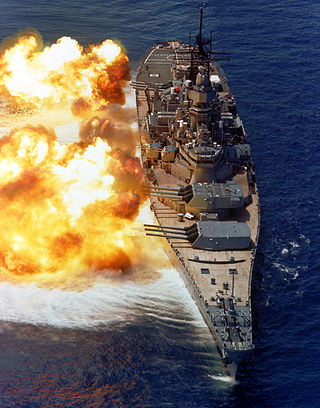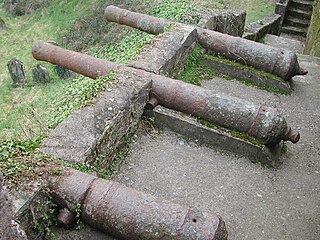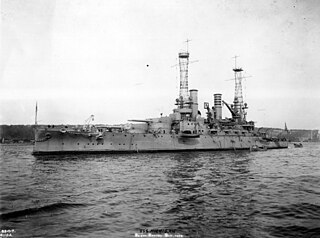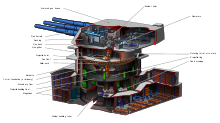
A battleship is a large armored warship with a main battery consisting of large caliber guns. It dominated naval warfare in the late 19th and early 20th centuries.

The Montana-class battleships were planned as successors of the Iowa class for the United States Navy, to be slower but larger, better armored, and with superior firepower. Five were approved for construction during World War II, but changes in wartime building priorities resulted in their cancellation in favor of continuing production of Essex-class aircraft carriers and Iowa-class battleships before any Montana-class keels were laid.

USS Mississippi (BB-41/AG-128), the second of three members of the New Mexico class of battleship, was the third ship of the United States Navy named in honor of the 20th state. The ship was built at the Newport News Shipbuilding Company of Newport News, Virginia, from her keel laying in April 1915, her launching in January 1917, and her commissioning in December that year. She was armed with a battery of twelve 14-inch (356 mm) guns in four three-gun turrets, and was protected by heavy armor plate, with her main belt armor being 13.5 inches (343 mm) thick.

A warship or combatant ship is a naval ship that is built and primarily intended for naval warfare. Usually they belong to the armed forces of a state. As well as being armed, warships are designed to withstand damage and are usually faster and more maneuverable than merchant ships. Unlike a merchant ship, which carries cargo, a warship typically carries only weapons, ammunition and supplies for its crew. Warships usually belong to a navy, though they have also been operated by individuals, cooperatives and corporations.

The Iowa class was a class of six fast battleships ordered by the United States Navy in 1939 and 1940. They were initially intended to intercept fast capital ships such as the Japanese Kongō class while also being capable of serving in a traditional battle line alongside slower battleships and act as its "fast wing". The Iowa class was designed to meet the Second London Naval Treaty's "escalator clause" limit of 45,000-long-ton (45,700 t) standard displacement. Four vessels, Iowa, New Jersey, Missouri, and Wisconsin, were completed; two more, Illinois and Kentucky, were laid down but canceled in 1945 and 1958, respectively, before completion, and both hulls were scrapped in 1958–1959.

The Wyoming class was a pair of dreadnought battleships built for the United States Navy. Wyoming and Arkansas were authorized in early 1909, and were built between 1910 and 1912. These were the fourth dreadnought design of the US Navy, but only an incremental improvement over the preceding Florida class, and the last US battleships to use 12-inch guns. The primary changes were the adoption of a more powerful 12 in (305 mm)/50 caliber Mark 7 gun, addition of a sixth twin-gun turret and improved armor protection, including the first use of a torpedo bulkhead on American battleships. The Navy considered using more powerful 14-inch (356 mm) guns, but this would have caused delays and required larger docks.

In military organizations, an artillery battery is a unit or multiple systems of artillery, mortar systems, rocket artillery, multiple rocket launchers, surface-to-surface missiles, ballistic missiles, cruise missiles, etc., so grouped to facilitate better battlefield communication and command and control, as well as to provide dispersion for its constituent gunnery crews and their systems. The term is also used in a naval context to describe groups of guns on warships.

The Nevada class comprised two dreadnought battleships—Nevada and Oklahoma—built for the United States Navy in the 1910s. They were significant developments in battleship design, being the first in the world to adopt "all or nothing" armor, a major step forward in armor protection because it emphasized protection optimized for long-range engagements before the Battle of Jutland demonstrated the need for such a layout. They also introduced three-gun turrets and oil-fired water-tube boilers to the US fleet. The two Nevadas were the progenitors of the standard-type battleship, a group that included the next four classes of broadly similar battleships that were intended to be tactically homogeneous.

The New Mexico class was a class of three super-dreadnought battleships built for the United States Navy in the late 1910s. The class comprised three ships: New Mexico, the lead ship, Mississippi, and Idaho. Part of the standard series, they were in most respects copies of the Pennsylvania-class battleships that immediately preceded them, carrying over the same main battery arrangement of twelve 14-inch (356 mm) guns, but now increased to 50-caliber. They incorporated several other improvements, including a better arrangement of the secondary battery that increased its usability, a clipper bow that improved seakeeping, and an experimental turbo-electric propulsion system adopted on New Mexico. Like the other standard-type battleships, they had a top speed of 21 knots that allowed the fleet to operate as a tactically homogeneous unit.

The Mississippi class of battleships comprised two ships which were authorized in the 1903 naval budget: Mississippi and Idaho; these were named for the 20th and 43rd states, respectively. These were the last pre-dreadnought battleships to be designed for the United States Navy, but not the last to be built, because one more ship of a prior design was completed later under the 1904 naval budget. While the quality and technology of the weaponry and armor were first-rate, these ships included a variety of main, intermediate, secondary, and tertiary gun sizes in a predreadnought configuration which became obsolete before the ships were completed.

The Florida-class battleships of the United States Navy comprised two ships: Florida and Utah. Launched in 1910 and 1909 respectively and commissioned in 1911, they were slightly larger than the preceding Delaware class design but were otherwise very similar. This was the first US battleship class in which all ships received steam turbine engines. In the previous Delaware-class, North Dakota received steam turbine propulsion as an experiment while Delaware retained triple-expansion engines.

HMS Dreadnought was a Royal Navy battleship whose design revolutionised naval power. The ship's entry into service in 1906 represented such an advance in naval technology that her name came to be associated with an entire generation of battleships, the "dreadnoughts", as well as the class of ships named after her. Likewise, the generation of ships she made obsolete became known as "pre-dreadnoughts". Admiral Sir John "Jacky" Fisher, First Sea Lord of the Board of Admiralty, is credited as the father of Dreadnought. Shortly after he assumed office in 1904, he ordered design studies for a battleship armed solely with 12 in (305 mm) guns and a speed of 21 knots. He convened a "Committee on Designs" to evaluate the alternative designs and to assist in the detailed design work.

Naval artillery is artillery mounted on a warship, originally used only for naval warfare and then subsequently used for more specialized roles in surface warfare such as naval gunfire support (NGFS) and anti-aircraft warfare (AAW) engagements. The term generally refers to tube-launched projectile-firing weapons and excludes self-propelled projectiles such as torpedoes, rockets, and missiles and those simply dropped overboard such as depth charges and naval mines.

A gun turret is a mounting platform from which weapons can be fired that affords protection, visibility and ability to turn and aim. A modern gun turret is generally a rotatable weapon mount that houses the crew or mechanism of a projectile-firing weapon and at the same time lets the weapon be aimed and fired in some degree of azimuth and elevation.

Aki (安芸) was one of two Satsuma-class semi-dreadnought battleship built for the Imperial Japanese Navy (IJN) during the first decade of the 20th century. She was the second battleship built domestically in Japan and the first to use steam turbines for propulsion. The ship was named for Aki Province, now a part of Hiroshima Prefecture. The ship saw no combat during World War I. Aki was disarmed in 1922 and sunk as a target in 1924 in accordance with the terms of the Washington Naval Treaty of 1922.
Secondary armament is a term used to refer to smaller, faster-firing weapons that were typically effective at a shorter range than the main (heavy) weapons on military systems, including battleship- and cruiser-type warships, tanks/armored personnel carriers, and rarely other systems.

Dante Alighieri was the first dreadnought battleship built for the Regia Marina and was completed in 1913. The ship served as a flagship during World War I, but saw very little action other than the Second Battle of Durazzo in 1918 during which she did not engage enemy forces. She never fired her guns in anger during her career. Dante Alighieri was refitted in 1923, stricken from the Navy List five years later and subsequently sold for scrap.

The dreadnought was the predominant type of battleship in the early 20th century. The first of the kind, the Royal Navy's HMS Dreadnought, had such an effect when launched in 1906 that similar battleships built after her were referred to as "dreadnoughts", and earlier battleships became known as pre-dreadnoughts. Her design had two revolutionary features: an "all-big-gun" armament scheme, with an unprecedented number of heavy-calibre guns, and steam turbine propulsion. As dreadnoughts became a crucial symbol of national power, the arrival of these new warships renewed the naval arms race between the United Kingdom and Germany. Dreadnought races sprang up around the world, including in South America, lasting up to the beginning of World War I. Successive designs increased rapidly in size and made use of improvements in armament, armour, and propulsion throughout the dreadnought era. Within five years, new battleships outclassed Dreadnought herself. These more powerful vessels were known as "super-dreadnoughts". Most of the original dreadnoughts were scrapped after the end of World War I under the terms of the Washington Naval Treaty, but many of the newer super-dreadnoughts continued serving throughout World War II.

The Kawachi class was a two-ship class of dreadnought battleships built for the Imperial Japanese Navy (IJN) in the first decade of the 20th century. Both ships bombarded German fortifications at Tsingtao during the Battle of Tsingtao in 1914, but saw no other combat in World War I. Kawachi sank in 1918 after an explosion in her ammunition magazine with the loss of over 600 officers and crewmen. Settsu was disarmed in 1922 and converted into a target ship two years later to meet the terms of the Washington Naval Treaty and served until she was sunk in 1945 by American carrier aircraft. The ship was refloated after the war and scrapped in 1946–1947.

Two South Carolina-class battleships, also known as the Michigan class, were built for the United States Navy in the early twentieth century. Named South Carolina and Michigan, they were the first American dreadnoughts—powerful warships whose capabilities far outstripped those of the world's older battleships.


















